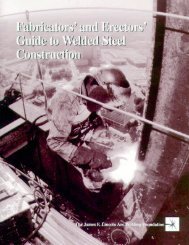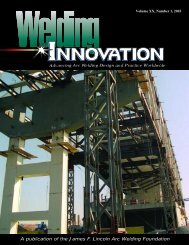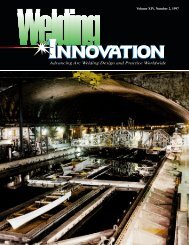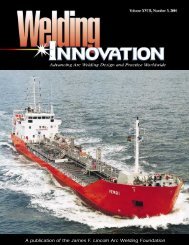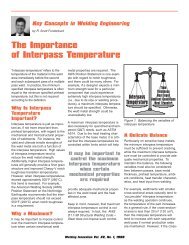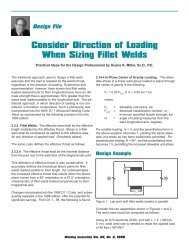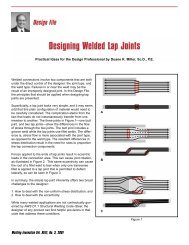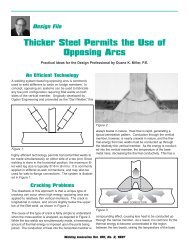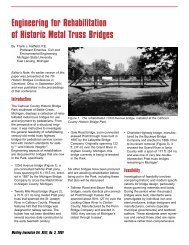A publication of the James F. Lincoln Arc Welding Foundation
A publication of the James F. Lincoln Arc Welding Foundation
A publication of the James F. Lincoln Arc Welding Foundation
You also want an ePaper? Increase the reach of your titles
YUMPU automatically turns print PDFs into web optimized ePapers that Google loves.
For angles less than 60 degrees, <strong>the</strong>re can be significant<br />
differences in weld volume. These are situations where <strong>the</strong><br />
Z-loss factor must be considered as well. Thus, for angles<br />
<strong>of</strong> 30–60 degrees, optimization <strong>of</strong> weld size makes sense,<br />
and <strong>the</strong> Z-loss factors can be considered at <strong>the</strong> same time.<br />
It must be recognized that o<strong>the</strong>r code provisions may fur<strong>the</strong>r<br />
affect <strong>the</strong>se results. For example, when optimized for<br />
minimum weld volume, welds on <strong>the</strong> obtuse side may be<br />
smaller than minimum fillet weld sizes as contained in Table<br />
5.8 <strong>of</strong> D1.1. The calculated sizes, if less than <strong>the</strong>se minimums,<br />
must be increased to comply with this requirement.<br />
There does not appear to be any intrinsic value in having<br />
welds on opposite sides <strong>of</strong> <strong>the</strong> skewed T-joint be <strong>of</strong> <strong>the</strong><br />
same size. If this approach is used, <strong>the</strong> resultant weld volumes<br />
will fall somewhere between <strong>the</strong> results for <strong>the</strong> same<br />
sized throat and <strong>the</strong> optimized sizes.<br />
After <strong>the</strong> welds are detailed, <strong>the</strong> joint must be welded.<br />
Practical considerations apply here too. It must be recognized<br />
that <strong>the</strong> ratio <strong>of</strong> <strong>the</strong> face width “f” to <strong>the</strong> throat dimension<br />
“t” constitutes <strong>the</strong> equivalent <strong>of</strong> a width-to-depth ratio<br />
for <strong>the</strong> root pass. On <strong>the</strong> obtuse side, this ratio is large,<br />
exceeding 1:6 for dihedral angle <strong>of</strong> 106 degrees or more. It<br />
is very difficult to get a single weld bead to “wash” out this<br />
wide without electrode manipulation (weaving). On <strong>the</strong><br />
acute side, <strong>the</strong> ratio is less than 1:2 for angles <strong>of</strong> 62<br />
degrees. This can lead to width-to-depth ratio cracking.<br />
Recommendations<br />
When determining fillet weld details for skewed T-joints with<br />
dihedral angles from 60–120 degrees, it rarely matters<br />
which method <strong>of</strong> proportioning <strong>of</strong> weld sizes is used. Using<br />
equal throat dimensions is a straightforward method, similar<br />
to what is typically done for fillet welds on ei<strong>the</strong>r side <strong>of</strong> a<br />
90-degree T-joint. Unless <strong>the</strong> weld size is large, optimizing it<br />
will probably not result in a smaller specified weld size.<br />
For fillet welds on skewed T-joints with dihedral angles from<br />
30–60 degrees, <strong>the</strong> Z-loss factor must be considered.<br />
Based on <strong>the</strong> specific dihedral angle, <strong>the</strong> welding process,<br />
and <strong>the</strong> position <strong>of</strong> welding, <strong>the</strong> Z-loss factor can be determined,<br />
and this dimension added to <strong>the</strong> required weld<br />
throat dimension.<br />
It is important to consider how <strong>the</strong>se dimensions should be<br />
communicated between <strong>the</strong> designer, fabricator, welder and<br />
inspector. The face dimension is a practical means <strong>of</strong> verifying<br />
that <strong>the</strong> proper weld size has been achieved.<br />
Opportunities<br />
<strong>Lincoln</strong> Electric Technical Programs<br />
<strong>Welding</strong> Technology Workshop<br />
June 10-14, 2002<br />
July 29 – August 2, 2002<br />
The purpose <strong>of</strong> this program is to<br />
introduce or enhance knowledge <strong>of</strong><br />
current thinking in arc welding safety,<br />
<strong>the</strong>ory, processes, and practices. The<br />
course is designed primarily for welding<br />
instructors, supervisors and pr<strong>of</strong>essional<br />
welders. Fee: $395.<br />
<strong>Welding</strong> <strong>of</strong> Aluminum Alloys,<br />
Theory and Practice<br />
October 15-18, 2002<br />
Designed for engineers, technologists,<br />
technicians and welders who are<br />
already familiar with basic welding<br />
processes, this technical training<br />
program provides equal amounts <strong>of</strong><br />
classroom time and hands-on welding.<br />
Fee: $595.<br />
Space is limited, so register early to avoid disappointment. For full details, see<br />
www.lincolnelectric.com/knowledge/training/seminars/<br />
Or call 216/383-2240, or write to Registrar, Pr<strong>of</strong>essional Programs, The <strong>Lincoln</strong> Electric<br />
Company, 22801 St. Clair Avenue, Cleveland, OH 44117-1199.<br />
<strong>Welding</strong> Innovation Vol. XIX, No. 1, 2002 11



